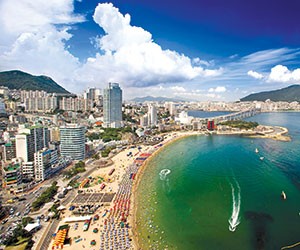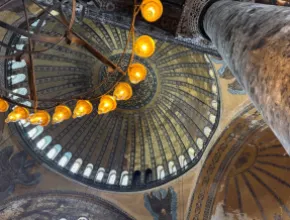The cell phone you’re texting from. The TV you’re watching. The washing machine your clothes are spinning in. The car you’re driving. Even the ship that brought them to the shores of America.
South Korea is a 21st century manufacturing and tech-innovation dynamo that plays a central role in keeping the world’s economy humming, with companies such as Samsung, Hyundai, LG and Kia acting as the pistons.
And that’s just the industrial output. Its popular culture imports, such as K-pop—Gangnam Style, anyone?—and soap operas that have spawned a sort of slavish cult following throughout Asia, are perhaps the ultimate signal that this little engine that could has arrived.
South Korea is the shining success story of the new century, having emerged from centuries as one of the world’s biggest hard-luck stories, and its meetings and conventions infrastructure is keeping pace with the nation’s ambitious nature.
Meeting Focus recently traveled to South Korea for the 2013 Korea MICE Expo, visiting the capital city of Seoul for the event; Incheon and the powerhouse “new city” named Songdo International Business District; Daegu, homeland of Samsung; and the palm-tree studded escape island of Jeju, where Koreans vacation and incentive attendees explore.
Seoul
Located about 12 hours by air from Los Angeles, the capital city of Seoul boasts more than 5,000 years of Korean history, and when combined with Incheon (located about an hour-and-a-half away) comprises the second-largest metropolitan area in the world with more than 25 million people.
According to the Korea Tourism Organization, the city, which held more than 550 conventions last year, is one of the world’s top seven—and one of Asia’s top five—meetings destinations, and the Union of International Associations ranks it as the fifth-most-popular incentive destination in the world, up from No. 11 just three years ago.
According to Maureen O’Crowley, vice president of the Seoul Tourism Organization, the booming city is set to open 110 new hotels and 55,000 more guest rooms by 2018, up from its current inventory of 155 properties and 26,000 rooms. The Seoul MICE Alliance, composed of 113 members, is a good first point of contact for meeting planners.
Seoul is divided by the Han River, which separates north from south and serves as a cultural dividing line between the two halves.PageBreak
The northern and more historic side, Gangbuk (which translates roughly to “River North”), offers the lion’s share of palaces and other cultural sites, as well as the sprawling Yongsan U.S. 8th Army Base and nearby Itaewon district, featuring Western-style boutique shopping and nightlife complete with red cowboy hat-wearing guides that ride helpful herd for tourists looking for direction.
Indeed, Seoul is a shopper’s heaven, with neon signs representing all the requisite international luxury brands beckoning buyers. Other major shop-till-you-drop districts include Insadong, featuring a more-traditional slice of Korean life, including antiques stores, teahouses and art galleries; Namdaemun, a locals’ spot that offers block after frenetic block—some 10,000 stalls and stores worth—of lower-priced goods of all stripes; Myeongdong, the largest shopping district and home to major clothing, cosmetics and department stores; and Dongdaemun Market, aka East Gate Market, a textiles and fashion center.
For a great night of entertainment, groups can enjoy Miso, the Original Korean Musical in the 344-seat Chongdong Theater. The upbeat, contemporary-yet-traditional love story is entertaining for audience members speaking any language—as it was designed as such—and features singing, acrobatic dancing and music, with traditional Korean garb photo opportunities with the cast after the show.
While the northern part of Seoul is a must-see for its museums and historic palaces—take a double-decker bus tour to get a good lay of the land—the primary district comprising the south side of the Han River, Gangnam (“River South”), bears more resemblance to Beverly Hills than its neighbor to the north.
The wide main streets of the oh-so-chic Gangnam District could very well have “Wilshire Boulevard” street signs lining them, and yes, you will see dapper young men parading about sporting the ubiquitous Gangnam Style attire. Gangnam is where the upwardly mobile move to live in luxury, and send their overachieving young to the best schools in the country.
Gangnam is also home to COEX Convention & Exhibition Center, where the Korea MICE Expo was held, a state-of-the-art, technologically sophisticated convention center offering four exhibition halls, 54 meeting rooms, more than 1 million square feet of space, a massive shopping mall and three five-star hotels connected to it.
Intercontinental operates two of the properties: the Intercontinental COEX and the Intercontinental Grand, which will offer the largest ballroom in the city—at more than 16,000 square feet—by January. The properties feature 1,200 rooms between them. Although both are very luxurious—especially by North American standards—the Grand is described as being the “CEO-level” property. Park Hyatt Seoul is also adjacent to the complex.PageBreak
Incheon
While Seoul blends old and new, Incheon blends the new with an unabashedly ambitious vision of the future.
With 2.7 million people, Incheon is the third-largest city in the nation and home to Incheon International Airport, the main port of entry for international air travelers.
The metro is emerging from an industrial past in a full embrace of the future with an entirely new city, Songdo, constructed on land reclaimed from the sea.
The Incheon Bridge, the world’s seventh–longest cable-stayed bridge, completed in 2009, reduced the travel time between Songdo and Incheon International airport by up to one hour, transforming the area.
The major meetings hotels are located near the airport, including the 523-room Hyatt Regency Incheon, which is situated within sight of the airport. The property is undergoing a massive expansion and renovation scheduled to bring its room count to 1,025 in June, making it the largest Hyatt outside of the U.S.
According to Chris Kim, director of sales for the property, the hotel will be the third-largest in South Korea after its new West Tower is completed in June, and is connected to the airport and other local attractions, including quaint Eurwangni Beach, by monorail. Kim says the Korean Air-owned hotel has been ranked the best service hotel in South Korea for three years, has a large convention floor and a ballroom that can accommodate up to 500, and is popular with pharmaceutical companies such as Pfizer.
Another popular area attraction is Wolmi Island Amusement Park, which is accessible from Incheon via a short ferry ride to Wolmido Island, with a new bridge connecting the island back to the mainland. Besides an amusement park, the heavily vegetated island offers a good opportunity for a nature hike and a commanding view of the port of Incheon from its observatory. No visit to Incheon would be complete without at least an hour exploring the packed alleyway shopping district of Shinpo Market, where locals hock various low-cost wares.PageBreak
Daegu
Located a hair under two hours southeast of Seoul via Korea Train eXpress (KTX), the nation’s ultra-efficient high-speed rail system, Daegu is a forward-looking industrial powerhouse of more than 2.3 million and the hometown of Samsung, which began its life rather modestly in 1938 as a manufacturer of noodles. The rest, as they say, is history.
Although no longer based in Daegu, the corporate giant still has a professional baseball team—Koreans absolutely love baseball and combine a day at the park with feasting on fried chicken—here. Daegu is also known as a center for agriculture—although its apple production is being impacted by climate change—textile manufacturing, information technology, medical tourism and higher education.
“We are a pioneer in the convention and visitors bureau business in Korea,” says Yung-Ho Park, director of the Daegu CVB, explaining that his CVB was the first in the nation. “Our city is very well positioned for technology tours. The Samsung mobile phone factory is 20 kilometers away; Hyundai is one-and-a-quarter miles away in Changwon. Since our city is surrounded by Korean industry, it is very easy to arrange tours.”
Daegu EXCO, the city’s convention center, opened in 2001 and expanded its main hall in 2011. The facility offers a total of 270,000 square feet of space, has a state-of-the-art performing arts theater and has hosted many major high-profile international conferences, such as UNESCO and the World Energy Congress. Major properties in Daegu include the Hotel Inter Burgo, a 342-room property attached to EXCO, and the Sheraton Daegu Hotel, a 242-room property with 21,500 square feet of function space and all of the Western amenities North American travelers are accustomed to back home.
The city is also gearing up to welcome a Marriott property near its rail station in 2015.
Jeju Island
In stark relief to the over-achieving Seoul, Incheon and Daegu, Jeju Island is a laid-back vacation destination that offers an impressive meetings and incentives product. The southernmost province of South Korea, Jeju is like a nation unto its own, with a distinctive dialect and a spirit of independence.
Sort of the Hawaii of Korea, Jeju offers a tropical-like setting with swaying palm trees, tangerine orchards, miles of coastline and a resort landscape that boasts the major hotel brands familiar to North American planners and a convention center with technology that probably surpasses the majority of American facilities. Perhaps surprising to see such an advanced facility in a resort locale, the Jeju ICC (International Convention Center) has the capability to offer simultaneous translation services and contains a variety of major halls and breezy outdoor spaces for large receptions and exhibits.
The Hyatt Regency Jeju is among a number of premier properties located about 15 minutes from the ICC via shuttle, and is situated on perhaps the best slice of coast on the island, with a massive lawn expanse that is popular for receptions for groups that have included Amway. The 223-room hotel just wrapped a massive renovation of its pool area with an eye toward reception space, more seating and cabanas.
Fifty-four percent of the Hyatt Regency Jeju’s rooms feature ocean views, and the property offers 35 traditional Korean Onsen rooms that are heated from the floors.
Off-site excursion options include a drive to visit the island’s tough-as-nails “Women Divers,” who have plied the waters off the coast since the 12th century. Many are past the age of 80, and they wore cotton clothes until the 1960s. The Jeju Museum of Art, a recently opened, architecturally significant fine arts and culture oasis owned by a member of the Samsung family, is the ideal location for a refined reception, and the Jeju Island Folk Museum is the best place to start to understand the unique culture and history of the island and its ruggedly independent inhabitants.







